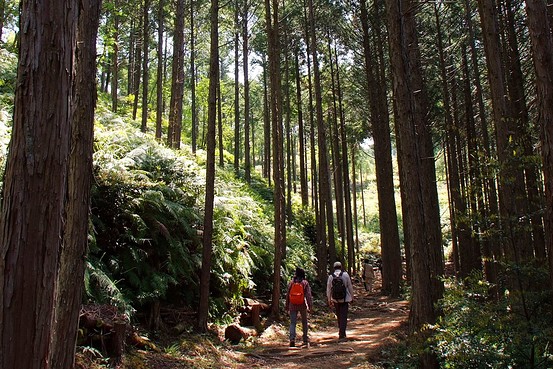
Several hundred thousand people climb Japan’s Mount Fuji every year, many of them in the peak period of July and August. But for an altogether more secluded and spiritual hiking experience, the Kumano Kodo region four hours south of Osaka offers an ancient network of pilgrimage trails and majestic shrines set among the densely forested mountains of the Kii Peninsula.
The Kumano Kodo—meaning “Kumano old roads”—includes the Buddhist retreat of Mt. Koya and the temple area of Yoshino, sites that are relatively well-visited because of their proximity to Kyoto and Osaka. It also includes the three grand Shinto shrines, or “sanzen,” near the southern tip of the peninsula—an appendage of the main Japanese island of Honshu—and the pilgrimage pathways that link all these locations.
The sanzen and their accompanying trails have largely been forgotten in Japanese collective memory as the locus of national culture shifted north to Tokyo. The region draws about 15 million visitors a year, although much smaller numbers trickle into the sanzen area, which never feels crowded. By comparison, more than 100 million people a year visit the country’s most popular national park, Fuji-Hakone-Izu.
The Kumano Kodo trails make up a diffuse, lattice-work network that weaves through valleys, along river banks, up mountain ridges and through traditional communities. Most of the trails are well-marked and in good condition. Bridges and stairs have been built in places, and it is common to come across an ancient stone monument or well-tended little shrine, such as the unprepossessing shrine of Hosshinmon-Oji nestled among the arrow-straight cedar shafts at the start of a popular half-day hike to the grand shrine of Hongu Taisha.
Some sections of the trails follow paved roads, and there are trails suitable for anything from an afternoon hike to a multiday trek. There are places along these trails where you may find it difficult to believe you are in Japan. The haunting, densely forested mountains are reminiscent of Southeast Asia—the Cameron Highlands of Malaysia, perhaps, or the hill country around Sapa in northern Vietnam. Agriculture and traditional industry abound, with tea plantations, vegetable gardens and small workshops in full swing.
“For people interested in the roots of Japanese spirituality, here you can actually see it and feel it,” said Brad Towle, a Canadian who works for the local tourism bureau promoting the region to international visitors. “Here it is a little more isolated. You are beyond the set track. There is a rich spiritual culture as a backdrop to isolated hot springs. There is a thousand-year tradition of pilgrimage and spirituality.”
Getting into the heart of the Kumano Kodo region isn’t easy. Unlike almost everywhere else in Japan, no trains run into the area. It is accessible by car or bus—or by foot, over the hundreds of kilometers of pilgrimage trails that wind through the mountains.
Most accommodations are basic, Japanese-style family-run inns, or minshuku, with a few larger ryokan hotels in the bigger villages. Nightlife is nonexistent. The villages go promptly to sleep after the sun goes down. The Kumano Kodo region is about peace, tranquility, nature and contemplation.
The spiritual origins of the area date from before recorded Japanese history. In the earliest written texts, it was the Land of Yomi—the land of the dead—where ancestral spirits ascended into the layers of mountains that stretched to the sea.
When Buddhism arrived from China in the sixth century, it blended with nativist traditions, and the belief emerged that local deities were manifestations of Buddhist entities. Devotees from all levels of Japanese society, from members of the imperial family in Kyoto to samurai nobles to commoners, walked the trails seeking contact with the sacred.
At the hub of this pilgrimage network is the grand shrine of Hongu Taisha, second in importance only to the emperor’s shrine in Ise, several hundred kilometers to the northeast.
Unlike the bright orange or crimson of most major shrines in Japan, Hongu Taisha is a more earthen white and brown. Worshippers seem to take the prayer ritual—tossing a coin into a wooden box, pulling a large rope connected to a rattle overhead to call down the gods, clapping twice and bowing in prayer—very seriously here.
Once you’re done hiking, there’s plenty of opportunity for relaxation here too. There are several towns in the area with hot springs, or onsen. One of Japan’s oldest onsen towns is Yunomine, whose sulfurous airs announce themselves to the nose as soon as you arrive. At nearby Kawayu Onsen, the big adventure is to dig your own hot-spring pool at the edge of the river where the steaming waters come bubbling up through the gravel. When the pool becomes too hot, you simply plunge into the river to cool off.
Most Japanese tourist destinations also boast their own local culinary fare, but unusually, there is little to recommend this area, although one restaurant along the highway near Kawayu does advertise local boar and deer meat.
But bathing and eating are secondary pleasures of this beautiful, mysterious region.
“The important thing about coming to Kumano,” says Mr. Towle, “is going home, taking the feeling you have in Kumano and importing it into your daily life.”
Source: The Wall Street Journal




